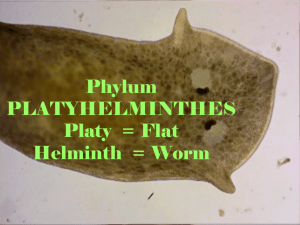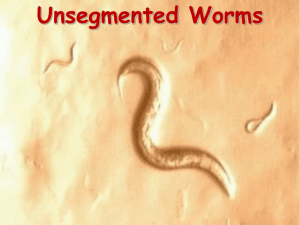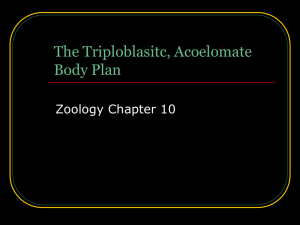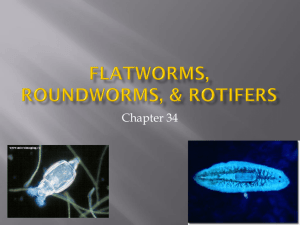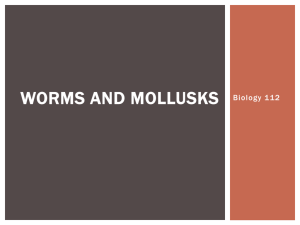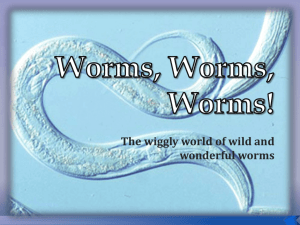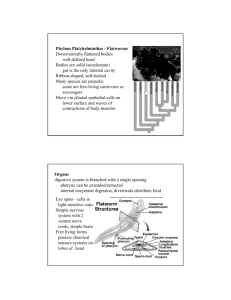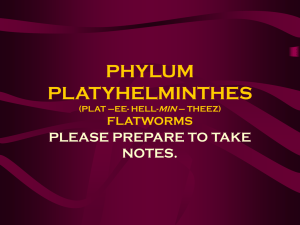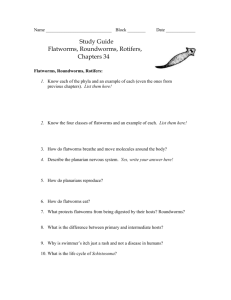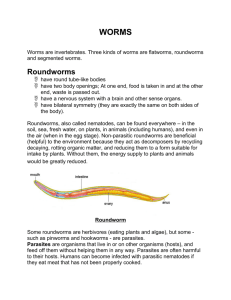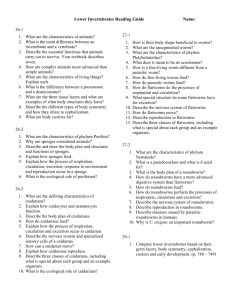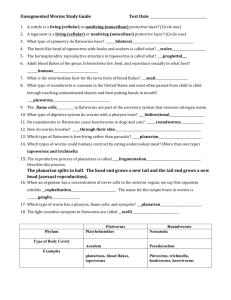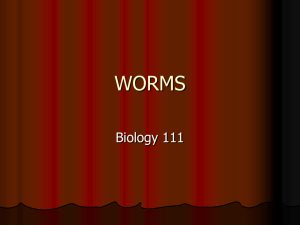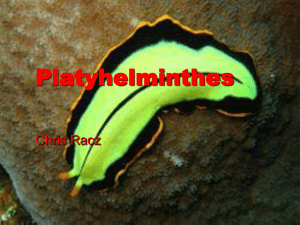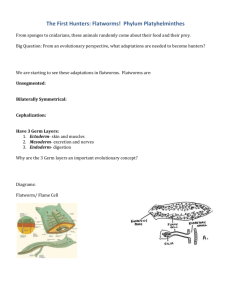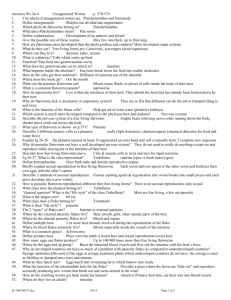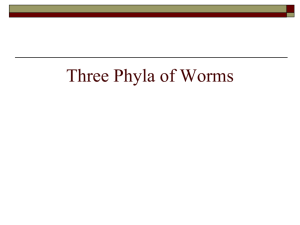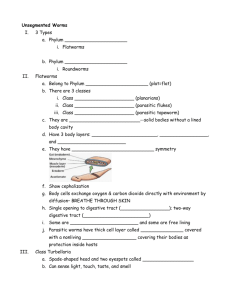Flatworms and Roundworms PowerPoint
advertisement
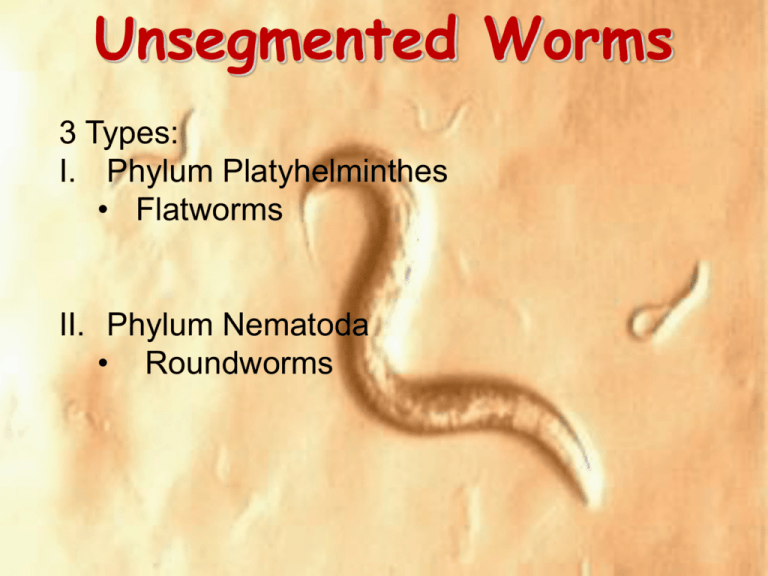
Unsegmented Worms 3 Types: I. Phylum Platyhelminthes • Flatworms II. Phylum Nematoda • Roundworms Flatworms Flatworms • Belong to Phylum Platyhelminthes. (Plat = flat) • There are three classes: – Turbellaria – Trematoda – Cestoda Characteristics of Flatworms • They are acoelomates – solid bodies without a lined body cavity • Have 3 body layers: ectoderm, mesoderm, endoderm • They have bilateral symmetry Characteristics of Flatworms • Show cephalization • Body cells exchange oxygen & carbon dioxide directly with environment by diffusion– BREATHE THROUGH SKIN • Single opening to digestive tract (pharynx); two-way digestive tract (bidirectional) Characteristics of Flatworms • Some are parasites and some are free living • Parasitic worms have thick cell layer called tegument covered with a nonliving cuticle covering their bodies as protection inside hosts Phylum Platyhelminthes • Includes 3 classes 1. Class Turbellaria (planarians) 2. Class Trematoda (parasitic flukes) 3. Class Cestoda (parasitic tapeworms) Class Turbellaria • Spade-shaped head and two eyespots called ocelli • Can sense light, touch, taste, and smell • Have 2 clusters of nerve cells or ganglia to form a simple brain • Nervous system composed of a nerve net • Capable of simple learning • Move by tiny hairs or cilia over a mucus layer that they secrete Class Turbellaria • Feed by scavenging for protozoans (microscopic, unicellular organisms) • Have a simple opening or mouth-pharynx • Flame cells remove waste Class Turbellaria • Are hermaphrodites (have male and female reproductive parts) • Can reproduce asexually by fragmentation • Are free-living Class Trematoda • Includes parasitic flukes • Require a host to live • Have suckers on both ends of the body • Can be endoparasites (live inside a host) or ectoparasites (live outside of a host) Class Trematoda • Nervous and excretory systems like turbellarians • Hermaphrodites • Schistosomiasis (disease caused by parasitic blood flukes) Schistosomiasis • Contracted by coming into contact with water contaminated with human urine or feces or touching certain snails that carry the blood fluke. • Worms can penetrate the skin. Blood Fluke Life Cycle Fluke Life-Cycles The long and complex life-cycle of the fluke can be made easier to understand through the use of a nonsense mnemonic : Every - Egg Mirror - Miracidium (free-living in water) Spotted - Sporocyst (in snail) Red - Redia (in snail) Certainly - Cercaria (free-living in water/snail) Met - Metacercaria (in 2nd intermediate host) Approval - Adult Class Cestoda • Includes tapeworms (parasite) • Tough outer tegument prevents being digested by host • Anterior end called scolex contains hooks and suckers for attachment to intestine of host Class Cestoda • Long, ribbon-like bodies • Nervous system extends length of body but lacks sense organs • Lacks mouth and digestive tract but absorbs digested nutrients from host • Grows by making body segments called proglottids Class Cestoda • Each proglottid produces egg and sperm that cross-fertilize with other segments and also self-fertilize (hermaphrodites) • Oldest, mature proglottids containing eggs at posterior end break off and pass out with feces Tapeworm Anatomy Roundworms Roundworms Roundworms • • • • • Belong to phylum Nematoda Pseudocoelomates (fluid filled body cavity) Slender bodies that taper on both ends Have mouth and anus Can be free-living or parasitic • Pinworms live in the human intestine. • Often get passed from child to child. • Only live in humans— cannot get pinworms from pets. Trichinosis—a disease from eating infected pork (cysts in pork contaminated with Trichinella species of worm) Cysts in Contaminated Pork Hookworms • Live in small intestine of mammal host (such as human, dog, cat, etc) • Suck blood and can cause anemia Heart worms • Parasitic roundworm that is spread from host to host through mosquito bites • Mosquitos spread the larva to the host, then the larva grow into adults in the heart and/or lungs of the host. • Only spread through infected mosquitos. There must be an incubation period in the mosquito before another animal can be infected by it. • Usually affects dogs, cats, wolves, coyotes, etc. Rarely affects humans. Parasitic Worms Poster • EVERYONE MUST PARTICIPATE! • Get creative and make it colorful! • NEATNESS COUNTS! • You will present your information next class period. Bellringer Write the questions and the answers. 1. What are the 3 classes of flatworms? 2. What does cephalization mean? 3. What type of body cavity do flatworms have? 4. What is the mouth/anus of flatworms called? 5. How does Class Turbellaria reproduce? 6. What is the head end of the tapeworm with hooks and suckers called? Bellringer Write the questions and the answers. 1. What phylum are roundworms in? 2. What type of body cavity do roundworms have? 3. List 3 types of parasitic roundworms. 4. How do heart worms spread? 5. What is the most common host for the Trichinella worm (the host that humans can get the worm from)? Bellringer Write the sentence and fill in the blank with the proper vocabulary word. 1. 2. 3. 4. 5. An ________ is a parasite that lives inside a host, while an ______ lives on the outside of the host. _________ are segments that can ________ because the sperm from one can fertilize the eggs of another. The _______ of a parasitic worm is a living protective layer, while the _____ is a nonliving protective layer. The _____ serves as the mouth and anus of flatworms and is part of a bidirectional digestive system because food enters and exits the same opening. The two _______ form a simple brain in flatworms, and the ________ can sense light and shadows but not detailed images.
